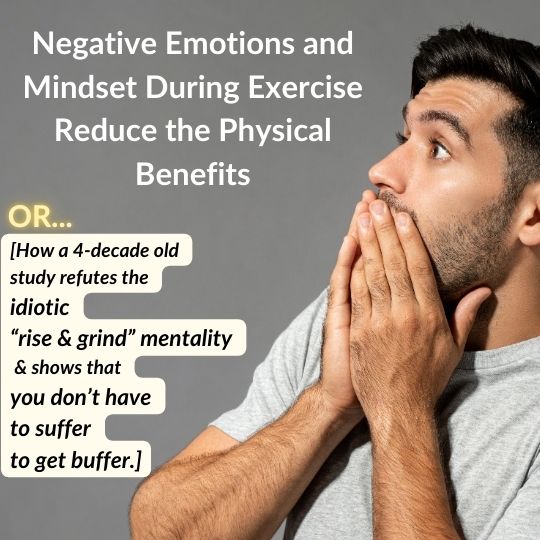Our mental and emotional state during exercise can influence whether we benefit from it or not.
I almost want to type that sentence twice just so the power and impact of this sinks in. Oh, why not.
Our mental and emotional state during exercise can influence whether we benefit from it or not.
I came across an old study that used actors and exercise. Actors can manifest various emotional states on demand so they are ideal candidates for assessing the influence of emotional state on the physiological response to an acute bout of exercise.
After reading about it, I cannot understand how a result this powerful from a study done in 1981 hasn’t directly influenced how the fitness industry presents exercise to the public for the last four decades.
The Details
The researchers employed actors for their ability to tap into emotional states. The actors were split into two groups: one was instructed to induce anger within themselves by envisioning frustrating and upsetting scenarios, while the other was directed to remain as tranquil, serene, and steady as possible. Both groups underwent monitoring of physiological functions such as heart rate, blood pressure, and breathing.
Subsequently, they participated in mild physical activities like stair climbing. The “angry group” either sustained or exhibited less healthy levels across all health metrics measured. Conversely, the “placid group” displayed the typical benefits associated with exercise. It was only in this group that the exercise yielded positive results, despite both groups performing identical exercises. It underscores the notion that while exercise is known to alleviate stress, the mental and emotional state during exercise is equally crucial to health improvement as the actual physical activity.
The Takeaway
If you hate it and are in a bad mood with exercise, then it won’t be as effective. Now you know why I’ve been focused on presenting intense and challenging exercise in a context of fun and playfulness. It is possible to work hard and enjoy yourself.
The idiotic “rise and grind” culture of fitness where you must suffer to be buffer is doing no one any favors.
There is another way, if only we choose to see it and shift our mindset.
CITATION:
Schwartz, G. E., Weinberger, D. A., & Singer, J. A. (1981). Cardiovascular differentiation of happiness, sadness, anger, and fear following imagery and exercise. Psychosomatic medicine, 43(4), 343–364. https://doi.org/10.1097/00006842-198108000-00007

